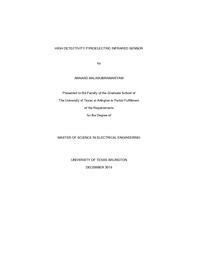
ATTENTION: The works hosted here are being migrated to a new repository that will consolidate resources, improve discoverability, and better show UTA's research impact on the global community. We will update authors as the migration progresses. Please see MavMatrix for more information.
Show simple item record
| dc.contributor.author | Balasubramaniyam, Annand | en_US |
| dc.date.accessioned | 2011-07-14T20:54:32Z | |
| dc.date.available | 2011-07-14T20:54:32Z | |
| dc.date.issued | 2011-07-14 | |
| dc.date.submitted | January 2010 | en_US |
| dc.identifier.other | DISS-11038 | en_US |
| dc.identifier.uri | http://hdl.handle.net/10106/5882 | |
| dc.description.abstract | The sensors which measure physical quantities by sensing them as thermal quantities and then converting the thermal signals into electrical signals are called thermal sensors. One such type of thermal sensor is a pyroelectric infrared sensor. Thermal sensors are not popular mainly because they are slow devices, and they have low sensitivity when compared to photon detectors. One major advantage of thermal detectors over photon detectors is that they can operate at room temperature. This is one of the main motivations for this research. The aim of the thesis is to design an uncooled, high detectivity pyroelectric infrared detector. The high detectivity is obtained by reducing the thermal conductivity from the sensor to the substrate or the heat sink. Pyroelectricity is defined as the change in polarization with corresponding change in temperature. Lead calcium titanate (PCT) is a material which is a ferroelectric perovskite. It has a very high pyroelectric co-efficient, high dielectric constant and if deposited in a proper ratio could yield a very high pyroelectric response in the range of 6 x106 V/W. The thermal conductance between the sensor and the substrate using the proposed design is found to be as low as 9.51x10-9 W/K, less than the radiative thermal conductance 3.69x10-7 W/K. Two kinds of absorber designs are proposed with this detector. The efficiency of the design and the directivity of the top surface of the infrared sensor are found to have 55° field of view on both sides. Various fabrication methods for fabricating the device have been discussed in detail and the best methods have been mentioned in comparison over the other types. The development of the absorber and its application in the detection mechanism is discussed in detail. | en_US |
| dc.description.sponsorship | Butler, Donald | en_US |
| dc.language.iso | en | en_US |
| dc.publisher | Electrical Engineering | en_US |
| dc.title | High Detectivity Pyroelectric Infrared Detector | en_US |
| dc.type | M.S. | en_US |
| dc.contributor.committeeChair | Butler, Donald | en_US |
| dc.degree.department | Electrical Engineering | en_US |
| dc.degree.discipline | Electrical Engineering | en_US |
| dc.degree.grantor | University of Texas at Arlington | en_US |
| dc.degree.level | masters | en_US |
| dc.degree.name | M.S. | en_US |
Files in this item
- Name:
- Balasubramaniyam_uta_2502M_110 ...
- Size:
- 2.196Mb
- Format:
- PDF
This item appears in the following Collection(s)
Show simple item record


